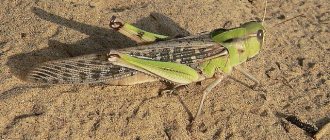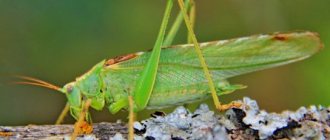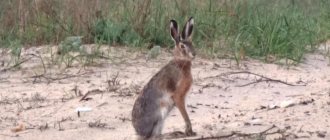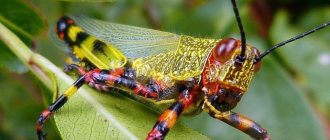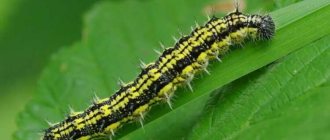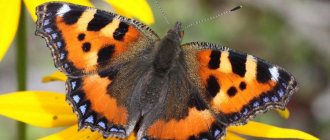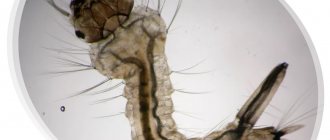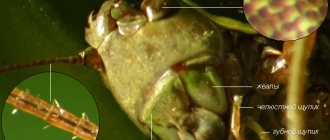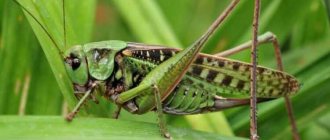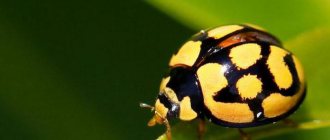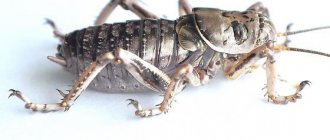Locusts appeared on the planet much earlier than humans. In ancient times, these pests were called the jaws of the wind. In ancient Greece, they prayed to the gods to avoid locust plagues. And these pests were feared like fire for a reason; today locusts are one of the most formidable enemies of agriculture.
The Asian locust is a gregarious insect belonging to a subspecies of migratory locust.
This type of pest lives in Central Asia, India, Afghanistan, Siberia, Mongolia, China and North Africa.
Description of the insect
The Locust family (lat. Acrididae) includes more than 1 thousand species of insects, of which 400 inhabit Asian-European countries, including Russia (regions of Central Asia, Kazakhstan, the Caucasus, southern Western Siberia and the European part). The most harmful and widespread species is the Asian locust, or migratory locust (Locusta migratoria).
According to its external description, it is similar to ordinary grasshoppers, only larger in size. As can be seen in the photo, the Asian migratory locust is a large insect, reaching 6 cm in length, has a green-brown or olive body color and well-developed wings, which help cover vast distances (up to several thousand kilometers) at a speed of 10-15 km/h . The body structure is typical for orthopteran insects and consists of 3 segments: head, thorax and abdomen. Locusts move along the ground with the help of jumping legs, making high jumps.
There are small antennae on the head, as well as powerful jaws and a curved sharp keel located on the pronotum. The wings are divided: the front wings are denser, brown in color, the hind wings are transparent yellow-green, more delicate in structure.
Lifestyle and nutrition
In the development of migratory locusts, there are 2 main phases: solitary and gregarious. It is in the latter that this insect poses a danger, devastating crops and destroying all plants that come in its way. Thanks to its omnivorous nature, it is able to actively feed, eating up to 0.5 kg of plant mass per day each! The locust eats leaves, flowers, branches, stems and fruits, preferring the morning and evening hours, and rests in the heat.
During the summer season, 1 female and her offspring eat as much as 2 sheep consume. Swarms of locusts sometimes number up to 1 million insects, so the raid of such a horde on the fields leads to the destruction of the crop. The locust's favorite delicacy is reed, as well as melons and garden plants.
Reproduction: laying eggs
The answer to the question of how long migratory locusts live depends on many external factors that influence the life cycle of the insect: nutrition, climate, etc. It is believed that they can live from 8 months. up to 2 years.
In the solitary phase, the locust exists as a large green insect, which is also called the “green filly”. She is harmless and leads an inactive lifestyle. This is the period when females mate with males and lay eggs after 30-40 days, which occurs in the 2nd half of summer.
When laying eggs, the female envelops them in a foamy liquid secreted from the glands, which quickly hardens in air. At the same time, it forms several capsules (pods) with a lid, each containing 50-100 eggs. In total, the total masonry can be 300-350 pieces. During the summer season, each female can form up to 3 generations of offspring.
The place for the egg capsule is selected in loose, preferably sandy and sufficiently moist soil. Popular places for laying are floodplains and banks of reservoirs, surrounded by sedge and reeds. At the beginning of autumn, with the arrival of cold weather, all adult individuals (females and males) die. During the winter months, the masonry does not freeze even in severe frost.
Appearance
A large insect, body length ranges from 35 to 45 mm in males and from 45 to 55 mm in females. The antennae are short. Mandibles (jaws) are blue. The elytra are shiny with brown spots, distinctly longer than the abdomen. The wings are transparent with a faint yellowish-green tint and black veins. The body shape depends on whether the individual belongs to the gregarious or solitary phase. Individuals of the solitary phase have a pronotum without constrictions and a high, arched median carina in profile. In individuals of the gregarious phase, the pronotum is saddle-shaped with a clear constriction and with a straight or slightly concave median carina (in profile).
The color is usually green, brown, yellowish-green or gray, but can also vary depending on the phase.
Development of locusts: from larva to imago
The development of the insect in question is characterized by 3 stages (egg - larva - imago), i.e. this is an incomplete transformation. Migratory locusts appear in the form of larvae only at the beginning of next spring, bypassing the pupal stage. This happens after the soil warms up to the desired temperature, usually in May.
The larvae are similar to adult insects, only smaller in size. As they develop, they molt several times (4-5), gradually increasing in size, which occurs within 35-40 days. Plants rich in protein serve as food for the younger generation: wheatgrass, reed, wild cereals.
In the solitary phase, the insect can exist, quietly feeding all summer and then laying eggs to start a new generation. Completely harmless green fillies have a small bulge (“hump”) on their backs and lead an inactive lifestyle.
How to deal with locusts in your area
Chemical and biological drugs
Karate Zeon
A pyrethroid insecticide quickly penetrates the insect's integument and acts on its nervous system. The feeding activity of the pest is blocked, paralysis and death of the locusts occurs.
To combat the pest, solutions of different concentrations are prepared. For single locusts and younger larvae, 7 ml of the drug is diluted in 10–20 liters of water. For older larvae, you will need 10 ml of product per 10 liters of water.
Clothiamet
New generation enteric-contact insecticide. Used during mass emergence of locust larvae. First, 0.5 g of the drug is thoroughly mixed with 2–3 liters of water, then the liquid is added to a volume of 10 liters.
Mospilan
The drug, without a toxic odor, has a nerve-paralytic effect on the pest. One treatment protects plants for 30 days. For spraying, 2.5 g of powder is dissolved in 1 liter of water, then 8–10 liters of water are added to the concentrate.
Metarizin
Biological product based on an entomopathogenic fungus. It grows into the body of the larvae, causing mycosis and death of the pest. Safe for humans and soil. Protects against locusts for several years.
It is recommended to apply the drug to damp soil during digging: 5–10 g per 1 sq.m. Metarizin can be added to irrigation water, sprayed on the soil, or mixed with fertilizers.
Traditional methods
Herbal infusions and mixtures will not help cope with the pest . A non-chemical method of control is manual collection of insects . This is suitable for small areas.
You can catch adult insects using ultraviolet traps . 2-3 light bulbs are attached to the trap structure. They are turned on during the day during the summer of insects. Locusts have good eyesight and ultraviolet light will attract its attention. Large containers of water are placed under the lamps, where the insects will fall.
Herd form, formation of a pack
The signal for the formation of a swarm of Asian migratory locusts is a lack of protein food, which happens on average every 10-12 years (the interval between epiphytoties). The gregarious phase of the existence of locusts is characterized by the reproduction of insects in extreme quantities, when the larvae, even having grown wings, sharply grow to 6-6.5 cm in length. They straighten their backs, acquiring a gray-brown spotted color, and begin to gather in swarms - columns, massively destroying all the plants around.
After the 4-5th molt, all insects in the flock acquire wings and begin their “nightmare” flight in search of food. A swarm of locusts can fly for 12 hours without a break, covering distances of hundreds of kilometers, and with a fair wind - up to 1 thousand km! When planting, insects even break tree branches with their weight.
Locust invasion
When migrating en masse, millions of insects produce a terrifying thunderous sound that arises from the combined cracking of their wings. Insects feed in a flock almost without interruption, trying to normalize the protein balance in the body. They completely eat all grain crops (wheat, barley, rye, corn and oats), gnaw all bushes and trees, pastures and grass in the fields. On their way, they eat the shoots of melons and legumes, leaves on root crops, etc.
They are capable of moving 50-300 km in the surrounding area per day. Moreover, along the way, many insects in the flock turn into predators, devouring their own kind, and not just plants.
What does this pest eat?
Both adults and larvae eat:
- rye;
- barley;
- wheat;
- sugar beets;
- beans;
- tobacco;
- peas;
- beans;
- soy;
- clover;
- sorghum;
- alfalfa;
- millet;
- rice;
- oats;
- corn;
- potato;
- cucumbers;
- sunflower;
- hemp;
- watermelons;
- rutabaga;
- poppy;
- melons;
- hop;
- cabbage;
- young fruit plants;
- fruits of bushes, pastures and haylands.
Communication of insects in a flock
Large communities of migratory locusts would not be able to survive for long if they did not communicate with each other. In a flock, they use sound and visual signals, touch, and use chemical irritants in the form of odors to communicate. In order to make sounds, insects have developed special organs. Thus, the locust makes a chirping sound, or the sound of stridulation, which is caused by rubbing its legs or wings on other parts of the body with a certain frequency and rhythm, for which they have teeth (80-90 pieces) located along the edges.
Insects produce other sounds using membranes located on the abdomen, such as clicks and pops, and they can also bang their heads on stems, leaves or the ground. Scientists suggest that echolocation is also used to coordinate the movement of large flocks. Migratory locusts, huddled in huge bands, sometimes numbering up to a million individuals, migrate over a certain area, flying from one field to another and destroying everything around.
Fighting locust infestation
A natural decrease in the number of locusts in a swarm occurs due to outbreaks of the disease, which are possible with a high density of insects in the swarms, as well as when they are infected in egg capsules. It is also destroyed by entomophages (predatory insects, which include ground beetles, ants, spiders, etc.) in the larval and adult stages. Locusts also have their own natural enemies: predatory insects, birds, etc.
The fight against locust infestations has been going on for many years and includes several methods:
- agrotechnical - autumn plowing of the land, which allows you to get rid of winter clutches of insect eggs;
- economic, which include sowing strips of industrial crops to protect grain, weed control, and development of virgin lands;
- chemical - treating the area by spraying insecticides from aircraft;
- poisoned baits laid out in the fields to kill single individuals.
Preventing a surge in migratory locust numbers during the breeding season helps reduce the damage swarms can cause to crops and plants.
Countermeasures
To prevent agricultural disasters, the number of insects at different stages of development of migratory locusts is monitored in breeding areas.
Such accounting makes it possible to predict the appearance of the gregarious form and apply insecticides in the phase of population growth, including barrier treatment of nesting sites.
The biological enemies of locusts are insectivorous mammals and birds (especially starlings), as well as some fungi that are pathogenic for orthopterans.
Agrotechnical prevention of the growth of the Asian locust population is:
- Drainage of floodplains of rivers and lakes using them for agricultural plantings.
- Improvement of pastures by mass sowing of forage grasses. The soil, densely entwined with roots, becomes unsuitable for laying eggs.
- Deep plowing of areas infested with locusts, with turning over of the earth layer and harrowing.
- Spring disc loosening along roadsides and slopes of irrigation canals.
Asian migratory locust (family name - locusts), type of development - indirect. During the period of mass reproduction, this pest poses a real threat to all agricultural crops.
The rise in the number of these insects can be prevented by agrotechnical and biological prevention, as well as timely treatment of breeding sites with insecticides.
